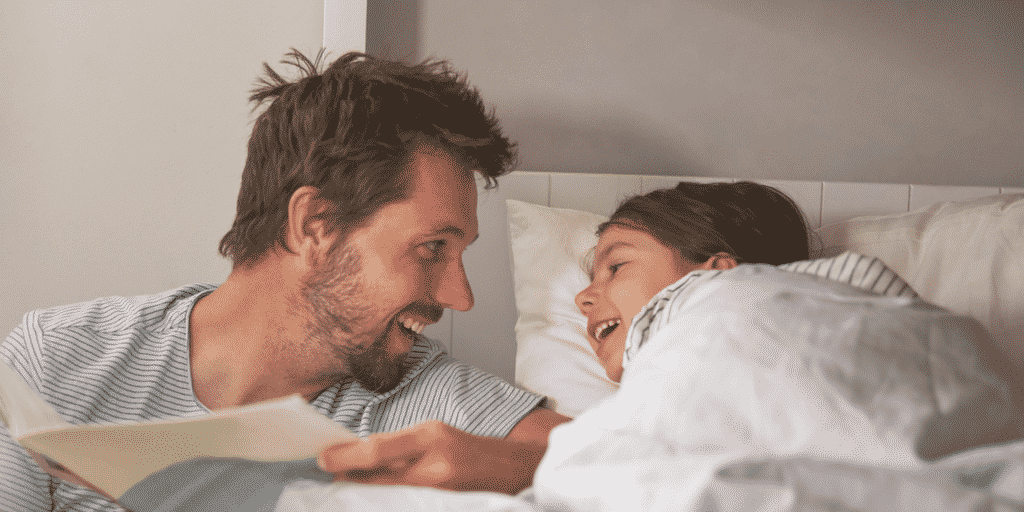By Roma Norriss
I remember being frightened at night as a child, calling out to my parents or being too afraid to call out. I would lie frozen in my bed watching shadows in the darkness. And I remember the few times I slept blissfully cocooned between them both. When I had my own kids, I was determined that they would never have to be frightened like that. We co-slept from birth and there were many beautiful and many annoying things about that. Still, my kids would wake several times each night, wanting to pee, to scream, to breastfeed. Somehow, I didn’t end up with the sleep-confident children co-sleeping seemed to promise. I needed to know more about how to help children sleep.
How Can You Help Children Sleep Through the Night?
 Sleep confidence can mean effortless bedtimes. Children don’t always need us to be right next to them to feel safe to go to sleep. Cuddles and stories can be more about choice than a must. And sleep-confident babies and children can sleep through the night. And yet sleep confidence seems, many times, to be a myth, an exception. Why?
Sleep confidence can mean effortless bedtimes. Children don’t always need us to be right next to them to feel safe to go to sleep. Cuddles and stories can be more about choice than a must. And sleep-confident babies and children can sleep through the night. And yet sleep confidence seems, many times, to be a myth, an exception. Why?
For children to sleep in the way I’ve described, they need to feel really safe. But most little children don’t tend to feel completely safe the minute they move out of sight of their parents. Evolutionarily speaking, this sensitivity is probably a throwback to times where being close to our caregivers was crucial for survival. At the slightest hint of separation, even the “separation” of falling asleep, any accumulation of fear in a child’s nervous system can get stirred up. General fears and anxieties picked up during the day often rear their heads around bedtime.That cloud of charged emotion drives bedtime resistance.
A Word on Co-Sleeping…
We at Hand in Hand Parenting don’t take a position on where your child should sleep. This choice is best left up to you and what works best for your family. Co-sleeping is how children have slept since the dawn of time, but we notice that children can grow up well-connected regardless of parental choices around feeding, childcare, carrying–and place of sleep. If you love co-sleeping in your family, enjoy it. Likewise, if you choose to sleep separately, you and your children can sleep peacefully and well, though to get there, you might first need to listen to their fears until those fears no longer haunt them. The tools I mention below are effective wherever children sleep.
Three Steps for Easier Bedtimes
Start with Rough-and-Tumble Play
Conventional wisdom advises not getting kids riled up before bedtime. But vigorous play before bed can be an ideal way to let off steam, help children sleep, and build that sense of connection children crave! Building play into the routine last thing can be a great release for the tensions your child has accumulated throughout the day. Just use this playtime as a chance for laughter, wrestling around, and nuzzling, without tickling.
Your child will show you how much of this playtime they need – most children want “more!” no matter how early you start. So know that you may need to set a limit after all the fun. Listen warmly if your child starts a big cry when you say it’s time to stop. Just Staylisten until he feels better! Your warm attention after you’ve set the limit helps your child feel secure in your love, and gradually, his need for an upset before bedtime will decrease. And your child’s ability to trust that he’s safe in bed will increase.
Daytime Staylistening: Your Attention in The Day Helps
One of the key ways parents can use the Hand in Hand approach to support the release of children’s fears and anxieties is by listening to a child’s upsets fully through the tool of Staylistening. Listening to a child’s tantrum about not liking their lunch, or to their passionate cry about not getting to play with the toy their friend has, helps them clear their feelings during the daytime when their system is not on high alert about sleep. They can enter the bedtime routine without such a big backlog of feelings, and this can be a comfort. Fortunately, setting warm, calm, sensible limits when needed throughout the day, then listening warmly while feelings pour out, also chips away at the fears that prevent sleep.
Listening Partnerships: Being A Caring Listener Isn't Easy
When children are releasing fear they often need to work themselves into a big, hot, tearless cry. They might become urgent, saying “I’m scared!” or “I need my teddy/water/daddy!” They might thrash around or become aggressive in the throes of intense fear. They might need some good, long cries, perhaps at ungodly hours, when you’ve already been caring for them all day. Being a caring listener for a child who is releasing intense fear leads to deep healing, but it is not easy! Most of us have never had an adult stay calmly with us through such a grippingly emotional time.
To build our ability to offer this kind of attention, it helps to have another adult listen to us while we work through our own feelings about sleep, or about our children’s fears. When we use a Listening Partnership (a listening exchange between two caring adults) to pour out our own feelings, whatever they might be, we become more able to listen to our children’s feelings when they need us most.
For example, when I began to help my children with their sleep issues, I had to wade through all those feelings I had as a child about being afraid at night and desperately wanting to be in my parents’ bed. I also had to work on the feelings behind my consequent passionate belief in co-sleeping and breastfeeding on demand. Interestingly, I noticed these strongly held beliefs melted away when I had released my own hurt. I became much more flexible in my thinking. I didn’t stop loving the great things about co-sleeping, but I found I could consider alternatives thoughtfully.
When Children Procrastinate at Bedtime
Let’s say you’ve been working on your own feelings about sleep and you’ve introduced rough-and-tumble play before bed. You’ve listened to some good cries, too, but your child is still protesting when you put them to bed. They suddenly become ravenous despite eating a hefty dinner, or they decide they MUST have a hot water bottle or socks or water.
These impulsive, rigid or urgent behaviours signal that emotional tension is present.
This is the time when, if you are sure their genuine physical needs have been met, you can move in kindly with a limit.
“No love, not tonight. Lamby is at Grandma’s/you’ll be fine without a hot water bottle/I think you’ve had enough to eat.”
 Just as you have in the day, you hold the limit and pour in your caring while they cry about how urgently they need that thing or rage about what a horrible parent you are. Through these passionate cries, children feel your warmth as you listen. This safe space lets a child’s feelings of fear find a safe way out. Over the nights that you hold the assurance that they will be able to lie down and sleep, they will eventually calm and do so.
Just as you have in the day, you hold the limit and pour in your caring while they cry about how urgently they need that thing or rage about what a horrible parent you are. Through these passionate cries, children feel your warmth as you listen. This safe space lets a child’s feelings of fear find a safe way out. Over the nights that you hold the assurance that they will be able to lie down and sleep, they will eventually calm and do so.
It can take a series of good bedtime cries before your child can go to sleep without fuss, so it helps to plan accordingly, including getting some good emotional support for yourself.
(A word on breastfed babies waking frequently in the night: If you’ve made the decision to night wean your child after the first six months or so of life, Hand in Hand offers the article, Baby Crying: Why Listening to Nursing Children Builds Connection. You might also be interested in the New Parent Podcasts, some of which address listening to the feelings of infants to help them with sleep.)
Hand in Hand Offers A Different Approach
The standard response to sleep issues is based on behavioral modification: techniques like controlled crying, or “Cry it Out,” aim to “teach” the child not to wake by withdrawing parental response to their signal of crying.
Elements of the Hand in Hand approach to sleep can sometimes be confused with this behavioural approach. However, Staylistening–pouring your love in while your child pours their feelings out–has an entirely different intention and effect.
The idea is to provide maximum safety for a young child while he releases the accumulated fear that prevents easeful sleep. We encourage parents to listen and connect, paying close attention so that our child receives the love and caring they crave while they show us (and actually become freed from) their feelings of fear and upset.
This parent-child partnership to release stored emotion has a deeply healing effect on a child. Fears subside over time, and children grow more confident that their parents will be there for them when things feel at their worst.
Your Children Can Sleep Well
Sleep can be one of the most pressing issues to work on in the family and the thing that feels most hopeless. If it’s any consolation, I can assure you that my previously cuddle-anxious, night- terrified, sleepwalking, panicky boy and my bedwetting, early-waking girl are now both fearless sleepers. I can tuck both in bed with a little squeeze and they will go off to sleep happily.
Using Listening Tools and the strategies above, yours can, too.
More Tools and Resources about Sleeping and Bedtime
Gain access to our Helping Your Children with Bedtime and Sleep class.
For more on babies and sleep read Five Ways Staylistening Is Different From Cry It Out
Here's why you should play before bed: The Benefits of Laughter at Bedtime
Roma Norriss is a Hand in Hand Parenting Instructor based in the UK. You can read more from her blog.



